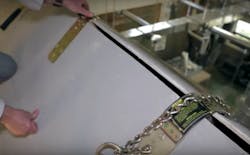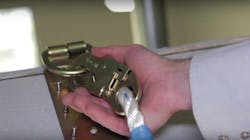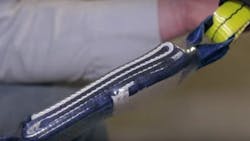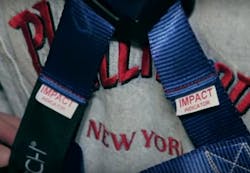[Note from the editor: I worked on a production building site in Rio Rancho, NM, one winter back in the 90s. My crew was installing the soffit, fascia, and exterior trim. One day, while we were working, a life-flight helicopter landed one street over and lifted a guy out.
It seems that he had been stapling off a roof by himself and stepped through a skylight hole. He landed on his back on the garage slab.
Because he was alone, no one knew he fell. Because it was a construction site, there was a lot of noise, so no one could hear him calling for help. It was not until he crawled out of the garage and waited until someone finally noticed him and called 911. This was before cell phones. It was also before fall arrest systems. The carpenter was paralyzed, but he lived. —DM]
OSHA says that if you can fall six feet, then fall protection is required:
"Unprotected sides and edges." Each employee on a walking/working surface (horizontal and vertical surface) with an unprotected side or edge which is 6 feet (1.8 m) or more above a lower level shall be protected from falling by the use of guardrail systems, safety net systems, or personal fall arrest systems."
Published on Feb 25, 2013, this episode of WxTV is an overview of the parts in a fall-arrest system:
- Anchors
- Ropes, catches, and lanyards
- Full body harness
The equipment is rated for a certain pound rating, but that applies to much more than your weight. It applies to the force your weight generates as it tumbles down a roof. As you fall, the mass times acceleration equation really adds up. #exponentialgrowth.
The fall protection system is anchored by—the anchor
OSHA requires that the anchor be rated to 5,000 lbs. There are many types of anchors: ridge anchors, beam anchors, clips, D-rings, and anchor plates ... this video highlights a ridge line anchor.
Ridge anchors straddle the ridge on the outside and can be fastened into the roof framing through nail holes. Read the directions for anchoring your anchor.
The model in this video can be nailed into the roof sheathing or the roof framing using different nails and nailing patterns.
- From the Catch-22 Department: Do you need fall protection to install fall protection? No. OSHA says you can take your chances while installing protection. Otherwise, nothing would ever get done.
- From the Spoiler Alert Department: some roof anchors are designed to be used once and then discarded.
The lifeline is attached to the anchor
The lifeline is basically a rope running down from the anchor onto which you can clip a lanyard. To clip the lanyard, you need a sliding ring that can lock into place. There should be a locking mechanism on the lifeline to prevent accidental opening.
Ropes must me man-made—no hemp. Use nylon or Spectra rope that meets OSHA and ANSI standards, ensuring a minimum arrest force of 900 lbs. This information should be on the label.
Always inspect ropes and lanyards before use for frayed braids, and chemical or UV damage. It is your lifeline (literally), and so you should take good care of the rope and replace ropes often.
Ropes can create a tripping hazard on a roof, especially if there are already air hoses and power cords. Retractable systems that work on inertia wheels, like seat belts, clean up the work area.
A common question is whether you can use a climbing rope. Yes, you can. Use a locking carabineer (rated to 22.2-kilo newtons or more) to clip to the roof anchor.
Tie a half-hitch loop and clip a locking carabiner to your harness.
Lanyard/rope length matters:
- The lifeline must be short enough to stop you from hitting the ground but not so long that you build up a tremendous force that will test your equipment.
- Shock-absorbing lanyards take the strain of a fall off the rope
[Shock-absorbing lanyards have extra loops of webbing stitched into the lanyard. The stitching will tear during a fall.]
Using a system that is designed for construction work on a roof makes work more efficient than using climbing gear, though, and it protects you're climbing gear.
A rope catch attached to a lifeline and lanyard makes it easy to move around a roof. The catch is activated when the weight pulls against it.
Safety Tip: While moving the catch up or down the lifeline to reposition, do not hold it by the rope sheath: because if you fall, you will not be able to put weight against the catch to activate its stopping mechanism. Use the ring attached to the lanyard as a handle when moving up and down roofs. #worthit
Full body harness anchors you into the fall arrest system
The harness should wrap over both shoulders, behind the back, encircle each leg, and include a sternum strap.
Adjusting your harness:
- Leg loops should be tight but not restrictive.
- The sternum strap should be even with the armpits at the center of the chest, tight enough to prevent shoulder straps from coming off the shoulders.
- The attachment point should be in the center of the back, between the shoulder blades.
Inspect equipment regularly and keep a record of inspections on the tags located on the harness itself.
Impact indicators are small sections of webbing that are folded over and stitched together. The stitching will tear if the harness stops a fall.
They show that the harness should be removed from service and replaced.
OSHA fall protection sections:
- 1926.500 — Scope, application, and definitions applicable to this subpart.
- 1926.501 — Duty to have fall protection.
- 1926.502 — Fall protection systems criteria and practices.
- 1926.503 — Training requirements.
- 1926 Subpart M App A — Determining Roof Widths — Non-mandatory Guidelines for Complying with 1926.501(b)(10)
- 1926 Subpart M App B — Guardrail Systems — Non-Mandatory Guidelines for Complying with 1926.502(b)
- 1926 Subpart M App C — Personal Fall Arrest Systems — Non-Mandatory Guidelines for Complying with 1926.502(d)
- 1926 Subpart M App D — Positioning Device Systems — Non-Mandatory Guidelines for Complying with 1926.502(e)
- 1926 Subpart M App E — Sample Fall Protection Plan — Non-Mandatory Guidelines for Complying with 1926.502(k)



